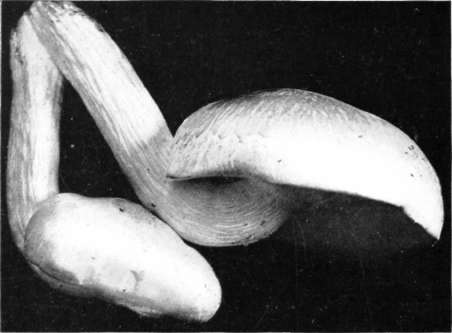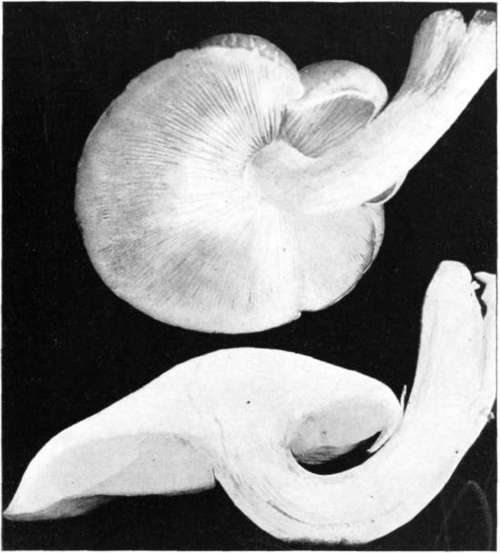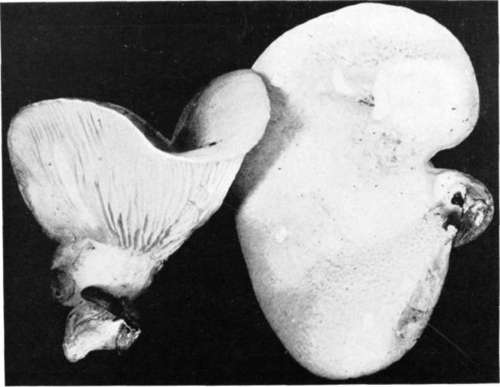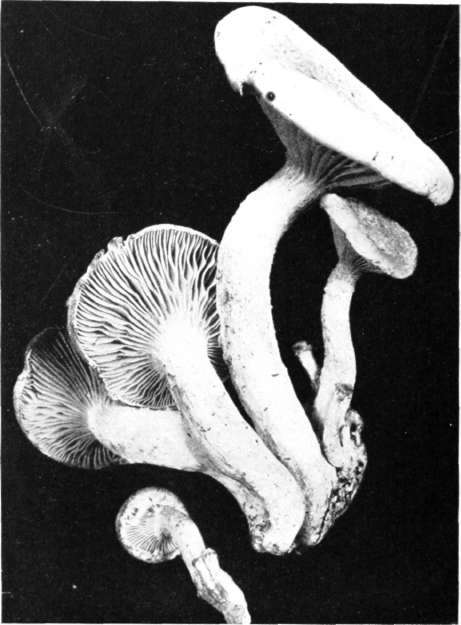Pleurotus
Description
This section is from the book "Studies of American Fungi: Mushrooms, Edible, Poisonous, Etc.", by George Francis Atkinson. Also available from Amazon: Studies of American Fungi: Mushrooms, Edible, Poisonous, Etc..
Pleurotus
The genus Pleurotus is usually recognized without difficulty among the fleshy, white-spored agarics, because of the eccentric (not quite in the center of the pileus) or lateral stem, or by the pileus being attached at one side in a more or less shelving position, or in some species where the upper side of the pileus lies directly against the wood on which the plant is growing, and is then said to be resupinate.
The gills are either decurrent (extending downward) on the stem, or in some species they are rounded or notched at the junction with the stem. There is no annu1us, though sometimes a veil, and the genus resembles both Tricholoma and Clitocybe, except for the position of the stem on the pileus. In Tricholoma and Clitocybe the stem is usually attached at the center, and the majority of the species grow on the ground, while the species of Pleurotus are especially characterized by growing on wood. Some species, at least, appear to grow from the ground, as in Pleurotus petaloides, which is sometimes found growing on buried roots or portions of decayed stumps which no longer show above ground. On the other hand species of Clitocybe, as in C. Candida (Fig. 91), often have an eccentric stem. This presents to us one of the many difficulties which students, especially beginners, of this group of fungi meet, and also suggests how unsatisfactory any arrangement of genera as yet proposed is.
Pleurotus ulmarius Bull. Edible. - The elm pleurotus is so called because it is often found growing on dead elm branches or trunks, or from wounds in living trees, but it is not confined to the elm. It is a large species, easily distinguished from the oyster agaric and the other related species by its long stem attached usually near the center of the cap, and by the gills being rounded or notched at their inner extremity. The cap is 5-12 cm. broad, the stem 5-10 cm. long, and 1-2 cm. in thickness.

Figure 105
Pleurotus ulmarius. Cap white, or with shades of yellow or brown near the center (natural size). Copyright.

Figure 106
Pleurotus ulmarius. Under view and section (natural size).
Copyright.
The pileus is convex, the margin incurved, then nearly expanded, smooth, firm, white or whitish, or with shades of yellow or brown on the center, and the flesh is white. The gills are broad, rather distant, sinuate, white or nearly so. The spores are globose, 5-8 µ in diameter. The stem is firm, eccentric, usually curved because of its lateral attachment on the side of the tree, and the horizontal position of the pileus.
The elm pleurotus has been long known as an edible fungus, and is regarded as an excellent one for food on account of its flavor and because of its large size. It occurs abundantly during the late autumn, and at this season of the year is usually well protected from the attacks of insects. It occurs in the woods, or fields, more frequently on dead trees. On shade trees which have been severely pruned, and are nearly or quite dead, it sometimes appears at the wounds, where limbs have been removed, in great abundance. In the plants shown in Fig. 105 the stems are strongly curved because the weight of the cap bore the plant downward. Sometimes when the plant is growing directly on the upper side of a branch or log, the stem may be central.
Pleurotus ostreatus Jacq. Edible. - This plant is known as the oyster agaric, because the form of the plant sometimes suggests the outline of an oyster shell, as is seen in Fig. 107. It grows on dead trunks and branches, usually in crowded clusters, the caps often overlapping or imbricated. It is large, measuring 8-20 cm. or more broad.
The pileus is elongated and attached at one side by being sessile, or it is narrowed into a very short stem. It is broadest at the outer extremity, where it becomes quite thin toward the margin. It is more or less curved in outline as seen from the side, being depressed usually on the upper side near the point of attachment, and toward the margin convex and the margin incurved. The color is white, light gray, buff or dark gray, often becoming yellowish on drying. The gills are white, broad, not much crowded, and run down on the stem in long elevated lines resembling veins, which anastomose often in a recticulate fashion. The spores are white, oblong, 7-10 µ long. The stem when present is very short, and often hairy at the base.
The oyster agaric has long been known as an edible mushroom, but it is not ranked among the best, because, like most Pleuroti, it is rather tough, especially in age. It is well to select young plants. Figure 107 is from plants (No. 2097, C. U. herbarium) collected at Ithaca, N. Y.
Pleurotus sapidus Kalchb. Edible. - This plant usually grows in large clusters from dead trunks or branches or from dead portions of living trees. It grows on a number of different kinds of trees. The stems are often joined at the base, but sometimes the plants are scattered over a portion of the branch or trunk. The cap is from 5-10 cm. broad. The plants occur from June to November.

Plate 34, Figure 107
Pleurotus ostreatus. Under view showing decurrent and anastomosing gills on the stem. Cap white, light gray, buff, or dark gray in color. Spores white (natural size, often larger). Copyright.

Plate 35, Figure 108
Pleurotus sapidus. Color of cap white, yellowish, gray, or brownish, with lilac tints sometimes. Spores lilac tinted in mass (1/2 natural size). Copyright.
The pileus is convex, the margin incurved when young, and more or less depressed in age, smooth, broadened toward the margin and tapering into the short stem, which is very short in some cases and elongated in others. Often the caps are quite irregular and the margin wavy, especially when old. It is quite firm, but the margin splits quite readily on being handled. The color varies greatly, white, yellowish, gray, or brownish and lilac tints. The flesh is white. The stems are usually attached to the pileus, at or near one edge. The gills are white, broad, not at all crowded, and extend down on the stem as in the oyster agaric. They are white or whitish, and as in the other related species are sometimes cracked, due probably to the tension brought to bear because of the expanding pileus. The spores are tinged with lilac when seen in mass, as when caught on paper. The color seems to be intensified after the spores have lain on the paper for a day or two.
It is very difficult to distinguish this species from the oyster agaric. The color of the spores seems to be the only distinguishing character, and this may not be constant. Peck suggests that it may only be a variety of the oyster agaric. 1 have found the plant growing from a dead spot on the base of a living oak tree. There was for several years a drive near this tree, and the wheels of vehicles cut into the roots of the tree on this side, and probably so injured it as to kill a portion and give this fungus and another one (Polystictus pergamenus) a start, and later they have slowly encroached on the side of the tree.
Figure 108 represents the plant (No. 3307, C. U. herbarium) from a dead maple trunk in a woods near Ithaca, collected during the autumn of 1899. This plant compares favorably with the oyster agaric as an edible one. Neither of these plants preserve as well as the elm pleurotus.
Pleurotus dryinus Pers. Edible. - Pleurotus dryinus represents a section of the genus in which the species are provided with a veil when young, but which disappears as the pileus expands. This species has been long known in Europe on trunks of oak, ash, willow, etc., and occurs there from September to October. It was collected near Ithaca, N. Y., in a beech woods along Six-mile creek, on October 24th, 1898, growing from a decayed knothole in the trunk of a living hickory tree, and again in a few days from a decayed stump. The pileus varies from 5-10 cm. broad, and the lateral or eccentric stem is 2-12 cm. long by 1-2 cm. in thickness, the length of the stem depending on the depth of the insertion of the stem in a hollow portion of the trunk. The plant is white or whitish, and the substance is quite firm, drying quite hard.
The pileus is convex to expanded, more or less depressed in the center, the margin involute, and the surface at first floccose, becoming in age floccose scaly, since the surface breaks up into triangular scales more prominent in and near the center, smaller and inconspicuous toward the margin. The prevailing color is white, but in age the scales become cream color or buff (in European plants said to become fuscous). The pileus is either definitely lateral (Fig. 109) or eccentric when the stem is attached near the center as in Fig. 110. The gills are white, becoming tinged with yellow in age, decurrent (running down on the stem) in striae for short distances, 4-5 mm. broad, not crowded. The stem is nearly central (Fig. no), or definitely lateral (Fig. 109), the length varying according to conditions as stated above. It is firm, tough, fibrous. The veil is prominent in young and medium plants, floccose, tearing irregularly as the pileus expands.
Figure no is from plants (No. 2478a C. U. herbarium) growing from knothole in living hickory tree, and Fig. 109 from plants (No. 2478b) growing on a dead stump, near Ithaca.
According to the descriptions of P. dryinus as given by Persoon, and as followed by Fries and most later writers, the pileus is definitely lateral, and more or less dimidiate, while in P. corticatus Fr., the pileus is entire and the stem rather long and eccentric. Stevenson suggests (p. 166) that corticatus is perhaps too closely allied to dryinus. The plants in our Fig. no agree in all respects with P. corticatus, except that possibly the lamellae do not anastomose on the stem as they are said to in corticatus. According to the usual descriptions corticatus is given as the larger species, while Fig. 109 of our plant, possessing the typical characters of dryinus, is the larger. The form of the pileus, the length and position of the stem, depends, as we know, to a large extent on the position of the plant on the tree. When growing from the upper side, so that there is room above for the expansion of the cap, the pileus is apt to be more regular, just as is the case in Pleurotus ulmarius, and the stem more nearly central. When the plant grows from a hollow place in the trunk as those shown in Fig. no did, then there is an opportunity for them to grow more or less erect, at least until they emerge from the hollow, and then the pileus is more nearly equal in its expansion and the stem is longer. Berkeley describes specimens of P. dryinus with long stems growing from a hollow in an ash, and Stevenson (p. 167) reports the same condition.

Plate 36, Figure 109
Pleurotus dryinus. Side and upper view. Plant entirely white, scales sometimes buff or cream colored in age (natural size). Copyright.

Plate 37, Figure 110
Pleurotus dryinus, form corticatus. Entire plant white, scales cream or buff in age sometimes. The ruptured veil shows in the small plant below (natural size). Copyright.
Continue to:


